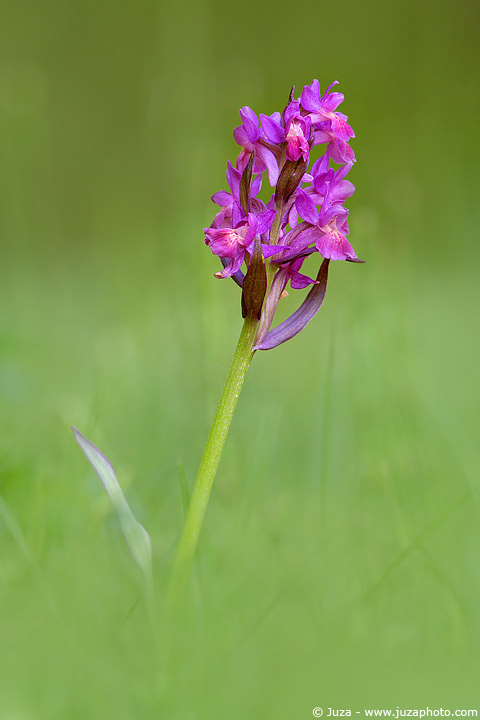Canon EOS 350D, Canon EF 600mm f/4 L IS USM, 1/60 f/5.6, iso 400, tripod. Mt. Nero, Italy. Years ago, when I decided to buy my first macro lens, I chose a Sigma 50mm Macro. It was a nice lens, it was very sharp and it reached life-size reproduction ratio (1:1). On the other hand, the results were not as good as the photos of many professional photographers where a nicely sharp subject stand out from a clean, out of focus backgroud. What was I doing wrong? Of course, my technique was far from perfect, but the lens played its role. The reproduction ratio is not the only factor that you have to consider when you choose a macro lens - the focal lenght is, in my opinion, even more important. Even though both a 50mm and a 180mm can be 1:1, the longer focal usually gives better images, because it gives a more out of focus background. The depth of field is the same - for example, f/11 gives the same depth of field both with a 50mm and a 180mm, but the longer lens has a narrower angle of view that gives a better background.
I discovered the advantages of long lenses in macro photography when I've met Ronnie Gaubert ([url]
www.pbase.com/ronnie_14187[/url] ). Ronnie is not one of the best macro photographers of the world - he is the best! I am always amazed by the perfection of his images...and I was surprised to know that he doesn't even use a true macro lens, he prefers a 300mm f/4 with extension tubes. He taught me the advantages of long focal lenghts, the natural light and the importante of background...since then, I've bought the 180mm Macro and, some months ago, the supertele Canon 600mm f/4 L IS USM. Of course the main purposes of the 600 are birds and wildlife - but sometimes I enjoy usign it as an unusual "macro" lens.
I've taken this photo this summer, during my Macro&Flora workshop on Mt. Nero. The Upper Nure Valley, and in particular the area between Mt. Nero, Mt. Bue and Mt. Maggiorasca is very interesting, both for landscape and flora; there are various species of orchids (as the Dactylorhiza sambucina that I portrayed in this photo) and some rare plants as Drosera Rotundifolia. Even though it was pretty easy to get close to this orchid, I preferred to use the 600, to "abstract" the subject from the surroundings and to give a nice "painting" look to the image. The soil was pretty wet and it was pretty difficult to keep the lens perfectly still; even with the sturdy Gitzo 1548 tripod, Wimberley head and image stabilization, I had to use ISO 400 to avoid blur. I carefully focussed on the orchid and I stopped down to f/5.6 to get a little more depth of field. I set the camera on self-timer and I activated the mirror lock up: these techniques are essential to avoid blur at slow shutter speed, in particular when the support is not perfectly stable. As usual, I checked the histogram to be sure of the exposure and I checked the sharpness with the playback zoom tool; even though the preview in the small LCD screen is far from accurate, it is possible to understand if an image is at least acceptably sharp or blurred by observing it at maximum magnification in the LCD screen.
The orchid was in shade - in my opinion, this is the ideal lighting for macro and flora. When the subject is in shade there are not dark shadows or bright highlight, and the colors are truly beautiful, if you post-processes well the photo (usually it is necessary to warm up a little the colors and to increase the contrast to get the best results from a subject photographed in shade).
Replies and comments
What do you think about this article?
Do you want to tell your opinion, ask questions to the author, or simply congratulate on a particularly interesting article?
You can join the discussion by joining JuzaPhoto, it is easy and free!
There is more: by registering you can create your personal page, publish photos, receive comments, join discussions and you can use all the features of JuzaPhoto.
With more than 257000 members, there is space for everyone, from the beginner to the professional.
|
|
sent on 30 Novembre 2014 (3:57)
I agree Juza, I had the 150mm sigma macro and the 180mm canon macro. I had far better results with the 180 canon and still feel it was one of the sharpest lenses I ever owned. But I still seem to get far more keeper flower photos from my wifes flower garden with the 300f4 very sharp great color and blurred backgrounds. Also much easier to use ! Love your site !
|
|
|
sent on 14 Maggio 2018 (20:03)
Dear Mr. Juza
I learned a lot from your articles. Your writings are very useful.
Your photos are perfect.
Zoltán Dobány Dr.
Hungary |


 JuzaPhoto contains affiliate links from Amazon and Ebay and JuzaPhoto earn a commission in case of purchase through affiliate links.
JuzaPhoto contains affiliate links from Amazon and Ebay and JuzaPhoto earn a commission in case of purchase through affiliate links.